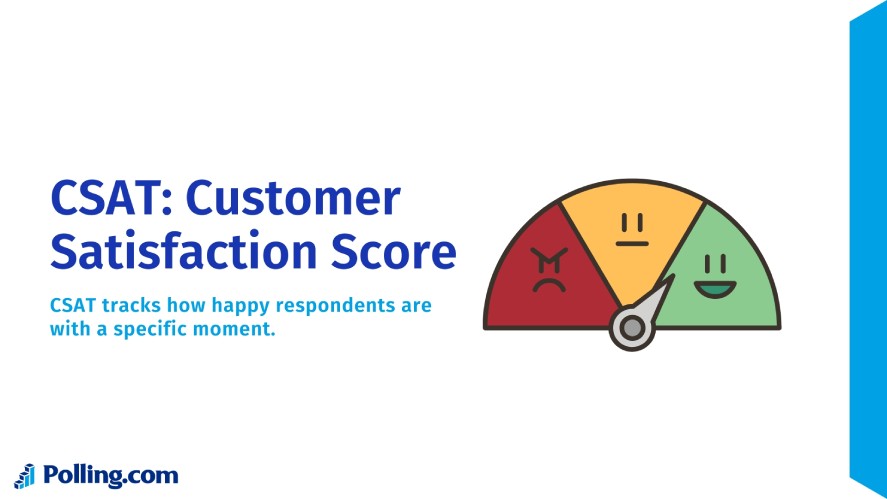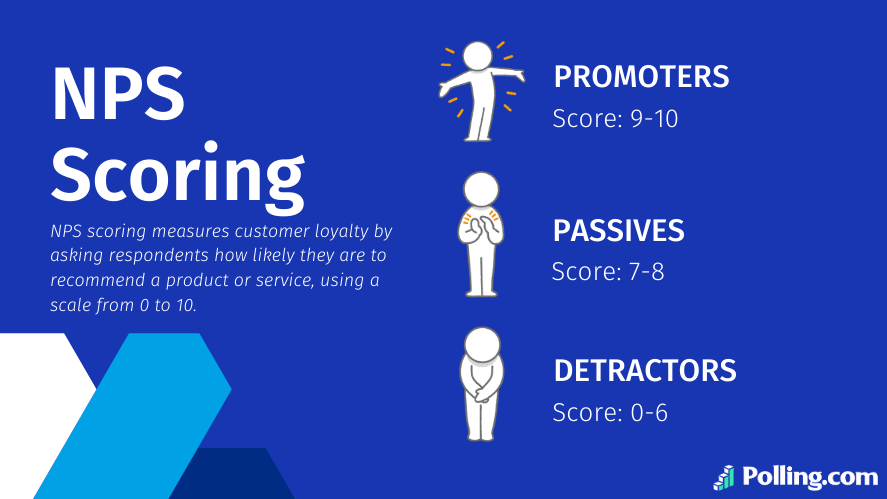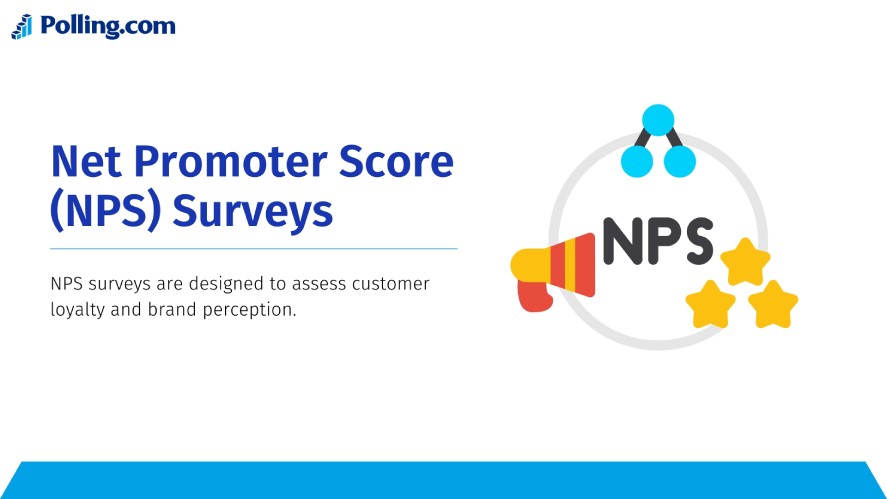
NPS CSAT: What Really Moves Your Customer Scores?
NPS CSAT are two of the most talked-about metrics in customer experience, but many companies still struggle to understand what actually drives them. Why do some customers give you perfect scores, while others churn even after a decent experience?
This article dives into the heart of what impacts your NPS CSAT metrics. You’ll learn how to measure both effectively, what really moves those scores, and how tools like Polling.com can help you take action in real-time. While many businesses collect feedback through surveys, few dig deep enough to connect the dots. This guide changes that.
Why Measuring Both NPS and CSAT Matters
Measuring either NPS or CSAT alone gives you only part of the story. Most businesses use customer feedback surveys, but they often stop at the score and miss the “why” behind it. Without knowing the drivers behind customer satisfaction or loyalty, it’s almost impossible to make meaningful changes.
In this guide, you’ll discover:
- What nps csat mean individually and how they differ
- Why both metrics are essential for a full picture of your customer experience
- The key drivers that influence these scores
- How to use tools like Polling.com to track and improve them
- Common mistakes and real-world success stories
Let’s start by defining the two metrics that everyone tracks, but not everyone understands.
What Are NPS and CSAT — and How Do They Differ?
Both nps csat measure how customers feel about your company, but they do so in different ways. One tells you about satisfaction after a specific interaction, while the other gives insight into overall loyalty and future behavior. Knowing when to use each one—and how to interpret the results—can completely change your approach to customer experience.
Defining CSAT
CSAT, short for Customer Satisfaction Score, measures how satisfied a customer is with a recent interaction, product, or service. It’s often the first customer satisfaction metric businesses adopt.

You’ll typically see it asked as: “How satisfied were you with your experience?” With responses on a scale from 1 (Very Unsatisfied) to 5 (Very Satisfied), or sometimes from 1 to 10.
The csat formula is simple:
(Number of satisfied customers / Total number of responses) x 100
For example, if 80 out of 100 people select 4 or 5, your csat score would be 80%.
This csat customer satisfaction metric is ideal for measuring:
- Support ticket resolution
- Post-purchase satisfaction
- Product usability
- Delivery experiences
It’s quick, easy to deploy, and provides direct feedback on specific touchpoints.
Defining NPS
NPS stands for Net Promoter Score. It gauges overall customer loyalty rather than satisfaction with a specific interaction. The standard NPS question is:
“How likely are you to recommend our company to a friend or colleague?” Scored from 0 (Not at all likely) to 10 (Extremely likely)
Respondents are then grouped into:

- Promoters (9–10): Loyal enthusiasts who will promote your brand
- Passives (7–8): Satisfied but unenthusiastic
- Detractors (0–6): Unhappy customers who may damage your brand
The NPS is calculated by subtracting the percentage of Detractors from the percentage of Promoters.
nps customer satisfaction is more relational than transactional. It reflects how your customers feel about your brand over time. That’s why it’s often used quarterly or biannually.
Why You Should Measure Both for a Full View
You might be wondering, csat vs nps — which one should I use?
The answer is both. Here’s why:
- CSAT tells you how customers feel after a specific moment. It gives insight into your support team, checkout process, or onboarding.
- NPS tells you whether those small moments are building a strong relationship—or not.
While a good csat rating means a customer had a positive experience, it doesn’t guarantee they’ll stay loyal. On the other hand, a high nps score means they’re likely to recommend you, but doesn’t tell you where their journey started going well.
By combining csat and nps, you can track how individual interactions impact long-term loyalty.
Key Drivers: What Moves Your NPS CSAT Scores
This is where it gets actionable. Let’s explore the specific factors that influence nps csat metrics, how to find them, and how to act on them.
For CSAT: Immediate Interaction Drivers
When customers rate you on csat, they’re thinking about what just happened. That’s why timing and context are everything.
Here are the biggest drivers:
1. Ease of Interaction
Customers want things to be smooth. Complicated checkout processes, confusing instructions, or slow support responses all hurt your csat score.
2. Resolution Quality
Did you actually solve the customer’s problem? A “yes” here almost guarantees a higher customer satisfaction score.
3. Emotional Satisfaction
Even if the outcome was good, a customer who felt rushed, ignored, or misunderstood will give a lower csat rating. Tone and empathy matter.
4. Timing of the Survey
Triggering a survey right after the interaction captures honest feedback while the experience is still fresh.
Best Practice:
Use platforms like Polling.com to automate csat surveys after important touchpoints such as:
- Order delivery
- Chat support completion
- Subscription signup
This real-time feedback reveals which parts of the journey need attention.
For NPS: Longer-Term Relationship Drivers

Unlike csat, nps reflects how the customer sees your company as a whole. Think of it as a loyalty indicator that’s shaped over time.
Here’s what moves it:
1. Consistency of Experience
Customers need to feel that they can trust you. If their last three purchases went smoothly but the fourth had issues, your nps customer satisfaction can take a hit.
2. Product and Brand Alignment
Your product has to keep solving real problems. If competitors are innovating faster, your cx score may fall even if service is good.
3. Emotional Connection
Are you delivering more than just a product? Loyal customers feel part of something. That emotion drives high NPS scores.
4. Advocacy Moments
Do you give customers a reason to promote you? Referral bonuses, community features, or excellent content can increase user satisfaction metrics and improve your nps score.
Drivers Common to Both
Some factors affect both csat and nps. These should be your top priorities because they improve multiple metrics at once.
1. Segmentation
Different customer types have different expectations. Client satisfaction metrics for enterprise users may look different than those for individuals.
Segment your feedback by:
- Customer type (SMB vs Enterprise)
- Lifecycle stage (New vs Longtime)
- Channel used (App vs Web vs In-store)
2. Feedback Loops
Acting on what customers say is critical. If customers feel ignored, even good products won’t boost your c-sat or nps.
Always:
- Acknowledge feedback
- Fix the root issue
- Let the customer know you fixed it
3. Data Quality
Garbage in, garbage out. If your survey setup doesn’t filter for repeat customers, or if timing is off, your insights will be flawed.
4. Tools and Dashboards
Use platforms like Polling.com to tie feedback data with actual customer behavior. This turns surveys into a true cx metric.
How to Identify Which Drivers Move Your Scores
It’s not enough to collect feedback. You need to find what’s really causing your scores to rise or fall.
Here’s how to do it:
1. Use Correlation or Regression Analysis
Compare csat score and nps score data with operational metrics like:
- Ticket resolution times
- Number of support interactions
- Product usage patterns
For example, if long support response times correlate with low csat, that’s your signal.
2. Analyze Open-Ended Responses
Read the comments. Customers will often tell you exactly why they scored the way they did. Group their feedback into themes like:
- Pricing
- Product performance
- Support experience
3. Create Driver Maps
Link every major touchpoint to csat and then to nps. For example:
Onboarding → CSAT → Long-term NPS
This shows you where to intervene for maximum impact.
4. Benchmark Over Time
Don’t just look at your own scores. Compare them against industry standards. Polling.com offers customer satisfaction metrics benchmarking to help you understand where you stand.
Building a Survey and Feedback Program with NPS CSAT in Mind
Now that you understand what affects your nps csat scores, the next step is building a feedback system that collects useful data and enables action. Without a structured approach, your surveys won’t reveal what’s truly influencing satisfaction or loyalty.
To get started, let’s look at how to design an effective survey.
Survey Design Best Practices

A well-designed survey can make the difference between valuable insights and noisy data. Here’s how to get it right.
First, Keep It Focused
Begin by asking one core question for each metric:
- For CSAT: “How satisfied were you with your recent experience?”
- For NPS: “How likely are you to recommend us to a friend or colleague?”
Next, include an open-ended follow-up to collect deeper insights. This gives context to your csat rating or nps score, revealing the reasoning behind the number.
Then, Time It Strategically
To gather accurate responses, timing is everything.
- Trigger csat surveys immediately after key interactions like purchases or support chats.
- Schedule nps surveys at regular intervals, such as every quarter or every six months.
This approach avoids the common mistake of sending NPS surveys too soon after a positive experience, which can lead to inflated scores. As a result, your feedback will reflect the full customer journey, not just isolated touchpoints.
Additionally, Segment Your Audience
Different types of customers have different needs and expectations. Therefore, it’s crucial to break your data down into segments, such as:
- New vs loyal customers
- Self-service vs full-service users
- By industry or region
- By product tier or plan
This segmentation improves your client satisfaction metrics by helping you pinpoint which experiences matter most to which group.
Also, Keep It Short and Simple
Long surveys reduce completion rates. To avoid fatigue, stick to 2–4 questions and make sure your survey works well on mobile devices.
By following these design tips, you’ll collect more meaningful data that reflects actual user satisfaction metrics.
Analytics and Action: Moving From Data to Improvement

Collecting feedback is only the first step. Next, you need to turn that information into decisions and action plans that improve your nps csat results.
Start by Visualizing Your Data
Use a dashboard to break down:
- CSAT by touchpoint, such as checkout, onboarding, or support
- NPS by customer segment or account type
- Trends in scores over time
This allows you to identify weak spots and detect patterns that link poor experiences to lower scores.
Then, Prioritize Improvements Based on Impact
Not every low score should lead to a big change. Instead, focus on areas where the customer experience has a measurable impact on revenue, retention, or referral rates.
For example, if poor onboarding leads to low csat rating and later results in a lower nps score, improving onboarding should be your first priority. That way, you’ll influence both short-term satisfaction and long-term loyalty.
Don’t Forget to Share Feedback Across Teams
Your customer experience doesn’t live in one department. For meaningful change, insights must flow across product, marketing, support, and leadership teams.
When everyone works from the same customer feedback data:
- Product teams can fix feature issues
- Support teams can improve response times
- Marketing teams can refine messaging based on customer satisfaction score data
Consequently, customer experience becomes a shared responsibility, improving both csat and nps results.
Most Importantly, Close the Loop
It’s not enough to collect and analyze feedback—you must act on it. When customers see their feedback leads to real changes, they become more engaged and more likely to recommend you.
So, follow up with detractors to address their concerns, thank promoters for their feedback, and show them what’s changed. This simple step helps improve both c-sat and brand loyalty.
Why Polling.com Is Your Edge

While understanding nps csat drivers is important, having the right platform to manage surveys and insights makes the process far more effective.
Polling.com offers an all-in-one platform that helps you measure, analyze, and act on both NPS and CSAT data—without the hassle of disconnected systems.
To Begin With, Polling.com Unifies Your Surveys
Polling.com allows you to:
- Trigger CSAT automatically after a support ticket or transaction
- Schedule recurring NPS campaigns with email or in-app prompts
- View all your results in a single, easy-to-understand dashboard
As a result, your team gets a clear view of what’s working and what isn’t—across all stages of the customer journey.
Moreover, Setup and Integration Are Simple
Polling.com integrates with tools you already use, including:
Therefore, you can link feedback data to actual behavior, which helps connect customer satisfaction metrics with real business outcomes like churn, referrals, or expansion revenue.
Even Better, You Get Real-Time Alerts
Whenever a customer gives a low csat score or leaves a critical NPS comment, your team is instantly notified. This allows for fast intervention, improving service recovery and reducing potential churn.
Plus, Built-In Driver Analysis Saves Time
Polling.com also helps you uncover what’s driving feedback by:
- Scanning comments for keywords and sentiment
- Grouping common issues like “slow shipping” or “confusing interface”
- Suggesting priority actions based on frequency and impact
This makes identifying csat and nps drivers easier and more accurate.
Case Example
Consider a SaaS company using Polling.com to gather CSAT scores during onboarding. Initially, CSAT was below 70%. After identifying that users struggled with the first login experience, they simplified the process. In the next quarter, CSAT jumped to 88% and NPS increased by 11 points.
Clearly, when you act on real-time data, the results follow.
Common Pitfalls and How to Avoid Them
Now that you know how to set up a feedback program, it’s equally important to avoid common mistakes that can hurt your nps csat tracking.
Mistake 1: Assuming Satisfaction Means Loyalty
A high csat rating after one interaction doesn’t guarantee the customer will stick around or recommend your brand. You need both CSAT and NPS to see the full picture.
Mistake 2: Triggering NPS at the Wrong Time
Sending NPS right after a single interaction can distort your data. Customers might still be forming their overall opinion, so it’s best to wait until they’ve had a broader experience.
Mistake 3: Ignoring the Follow-Up
If you collect feedback and do nothing with it, customers will stop responding. Always let them know their voice matters by showing how you’ve acted on their input.
Mistake 4: Measuring CSAT and NPS Separately
Some teams only track CSAT, while others only look at NPS. When you separate these, you miss the connections between daily experiences and long-term loyalty. Use platforms like Polling.com to bring both metrics together.
Mistake 5: Overlooking Segmentation
Without segmentation, you might miss how csat customer satisfaction varies by customer type. For example, enterprise clients may care more about dedicated support, while individual users focus on ease of use.
Therefore, always break down your feedback by segment, channel, and lifecycle stage.
Real-World Case Examples
Still unsure how theory becomes reality? These short examples show how companies have improved their nps csat scores by taking targeted action.
Example 1: SaaS Company Fixes Onboarding
Challenge: New users were frustrated during the setup process. Action: Simplified the onboarding flow and added tutorials. Results:
- CSAT increased from 65% to 84%
- NPS rose from 18 to 31 within two quarters
Example 2: Retail Brand Streamlines Checkout
Challenge: Too many steps in the online checkout process. Action: Reduced steps and enabled guest checkout. Results:
- Checkout csat rating scale improved
- NPS climbed by 9 points as detractor comments dropped
Example 3: Support Team Cuts Resolution Time
Challenge: Long support response times led to low c-sat Action: Introduced chat support and real-time SLAs Results:
- Support CSAT increased to over 90%
- Retention rate improved among users who interacted with support
Conclusion and Next Steps
Improving your nps csat scores doesn’t require guesswork. Instead, it takes clear metrics, the right tools, and consistent follow-through.
To Recap:
- CSAT captures satisfaction after individual touchpoints
- NPS reflects customer loyalty and long-term sentiment
- Both metrics are essential, but their drivers differ
- Use tools like Polling.com to measure, analyze, and act on feedback
- Avoid pitfalls like timing mistakes or ignoring feedback loops
What to Do Now:
- Review your current survey schedule—are you triggering CSAT and NPS at the right times?
- Map the customer journey and identify touchpoints that affect both metrics
- Use segmentation to understand different customer needs
- Implement a platform like Polling.com to centralize your efforts
- Start small—improve one journey, measure the impact, and expand from there
Success in csat and nps is about more than tracking numbers. It’s about understanding what those numbers represent—and acting to improve the experiences behind them.
